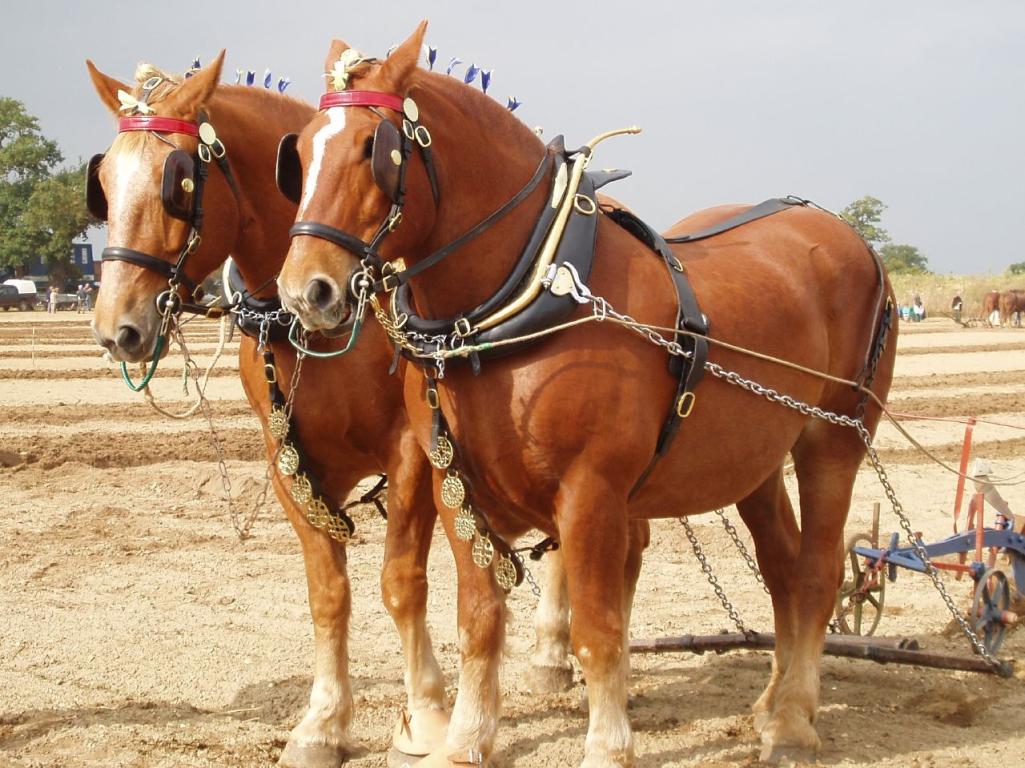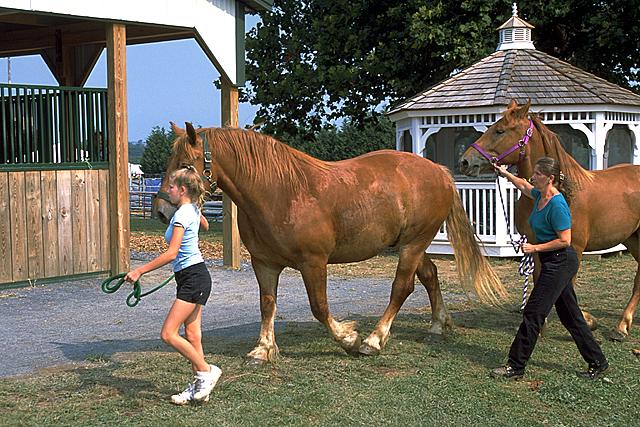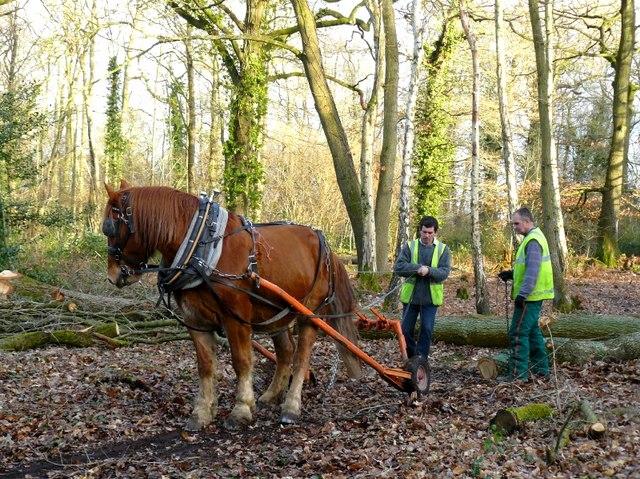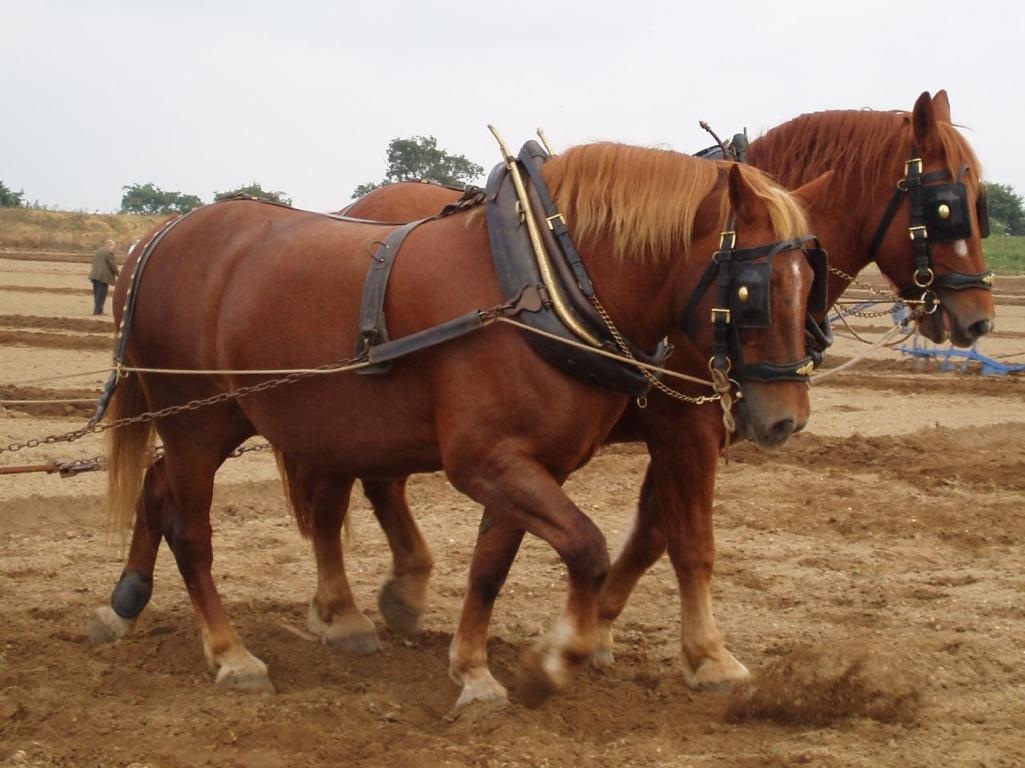
Continent: Europe
Country: United Kingdom
Weight: 750 – 1000 kg
Height: 163 – 170 cm



The Suffolk Punch originates from Suffolk County, in the east of England, more specifically in the rural region of the East Anglian Counties (Suffolk, Norfolk, and Cambridgeshire). Its history dates back to the 16th century, making it one of the oldest documented British draft breeds.
Geographical origin:
A land of clay plains and heavy soils, ideal for cereal farming, where a robust horse was essential for intensive agricultural work.
The Suffolk Punch was selectively bred for its ability to work deep soils, where other horses would struggle.
Cultural origin:
Closely tied to traditional English agriculture, the Suffolk Punch was bred by farmers determined to preserve a rustic, economical, enduring, and docile horse. The name "Punch" (literally stout or stocky) reflects its powerful and compact build.
Its uniform chestnut coat is an identifying hallmark of the breed, reflecting a long process of local selective breeding.
The Suffolk Punch embodies both the English countryside’s attachment to its rural heritage and the expertise of rigorous farmer-led selection, adapted to a demanding environment.
The Suffolk Punch is a breed with very limited numbers, whose breeding is concentrated in a few specific regions.
United Kingdom (historical homeland):
- Eastern England, mainly in Suffolk County (region of origin)
- Neighboring counties: Norfolk, Cambridgeshire, Lincolnshire
Breeding is often carried out by conservation farms, living history museums, heritage estates, and farmers committed to preserving local breeds.
The breeding of the Suffolk Punch remains highly limited and is the subject of coordinated conservation programs, in collaboration with organizations such as the Suffolk Horse Society (UK) and the Rare Breeds Survival Trust. Its distribution is intentionally restricted in order to maintain the genetic purity of the breed.
The Suffolk Punch holds major genetic importance, both for its unique heritage and its potential contribution to the genetic diversity of draft horses.
Ancient and preserved lineage:
The Suffolk Punch is one of the oldest horse breeds in the world to have remained genetically stable, with bloodlines tracing back to the foundation stallion “Crisp’s Horse of Ufford” (1768). Unlike other draft breeds, it has had very limited crossbreeding with foreign horses, making it a valuable genetic reservoir.
Exceptional genetic uniformity:
Its exclusive chestnut coat and uniform morphology are the result of consistent selective breeding, but this uniformity comes with a concerning narrowing of the gene pool, leaving the breed vulnerable. The Suffolk Punch is listed among the most endangered breeds in the UK by the Rare Breeds Survival Trust, further increasing its importance for genetic conservation programs.
Historically, the Suffolk Punch has contributed to the improvement of other draft or working horses worldwide, particularly in the United States, Canada, and Australia, thanks to its strength, hardiness, and reliable temperament.
In summary, the Suffolk Punch represents an irreplaceable genetic heritage, both for its originality and its value in preserving global equine diversity. Its conservation is essential to maintain viable genetic alternatives in the face of breed standardization.
The Suffolk Punch is one of the oldest and most uniform draft horse breeds in Europe, with a history deeply rooted in the farmlands of eastern England.
Ancient origins (16th – 18th century):
The breed dates back at least to 1506, the year of the first recorded mention of a local chestnut draft horse in Suffolk. The known foundation stallion is “Crisp’s Horse of Ufford”, born in 1768, from which almost all present-day bloodlines descend.
Locally selected by farmers to plow the region’s heavy clay soils, the Suffolk Punch was a working farm horse, never bred for ornament or prestige.
Development and recognition (19th century):
The official studbook was created in 1880 by the Suffolk Horse Society (founded in 1877), making it one of the oldest equine studbooks in the world.
Unlike other breeds, the Suffolk Punch was never extensively crossed with foreign breeds such as the Percheron or Clydesdale. This exceptional genetic purity makes it a true rarity in the equine world.
During the 19th century, the breed was exported to North America, Australia, and South Africa.
Decline in the 20th century:
The rise of agricultural mechanization after World War II caused the breed’s numbers to collapse. Many horses were sold for slaughter, and the breed nearly became extinct in the 1960s. A few passionate breeders, along with the Suffolk Horse Society, managed to keep some bloodlines alive on traditional farms.
Modern revival (21st century):
Since the 1990s, conservation efforts have intensified, supported by British associations dedicated to preserving heritage breeds.
Today, the Suffolk Punch is an emblematic breed of English rural heritage, showcased at events, agricultural museums, ecological farms, and conservation centers.
A symbol of strength, resilience, and connection to the land, the Suffolk Punch embodies the legacy of a farming tradition respectful of both soil and animals. Its survival stands as a testament to the determination of breeders and enthusiasts committed to preserving a bloodline over 500 years old
The Suffolk Punch is known for its exceptionally calm, reliable, and hard-working temperament, making it one of the safest and most appreciated draft horses.
- Docile – Easy to handle, even by people with little experience.
- Obedient – Responds well to commands, even under demanding working conditions.
- Steady – Maintains a consistent and predictable temperament, without mood swings.
- Attentive and willing – Enjoys working and keeps a good pace without needing excessive encouragement.
Work behavior:
Particularly enduring and courageous, especially in heavy tasks such as plowing or logging. Shows great dedication: does not shirk effort and does not tire quickly.
Its practical intelligence allows it to anticipate the driver’s commands or adapt to difficult terrain.
Relationship with humans:
Very affectionate and loyal, the Suffolk Punch often develops a strong bond of trust with its handler or driver. Ideal for family, educational, or heritage environments due to its mental stability.
In summary, the Suffolk Punch combines the quiet strength of a draft horse with a generous, gentle, and well-balanced temperament, making it a powerful yet reassuring work companion.
The Suffolk Punch is now classified among the most endangered horse breeds in the world, with a very limited global population. Despite this alarming reality, several positive trends are emerging for the future.
Critical risk of extinction:
According to the Rare Breeds Survival Trust (RBST), the Suffolk Punch is listed on the red list of priority breeds, with fewer than 500 registered breeding mares in the United Kingdom.
The low genetic diversity increases the risk of inbreeding and extinction in the medium term without targeted intervention.
Revival through conservation:
Active conservation programs led by the Suffolk Horse Society, agricultural museums, heritage estates, and dedicated farmers. Increased support from British government initiatives and NGOs working to preserve native breeds.
The Suffolk Punch is also used as an ambassador breed for English rural heritage, particularly in agritourism and cultural events.
New ecological and heritage uses:
- Horse logging in protected areas, where animal traction is preferred over heavy machinery.
- Organic farming work in regenerative agriculture systems.
- Promotion through ecotourism, rural demonstrations, and traditional carriage driving.
The survival of the Suffolk Punch depends on continuous mobilization around its heritage, ecological, and cultural value. Its future will rely on the ability to inspire new breeders and diversify its uses.
The Suffolk Punch is renowned for its natural hardiness, longevity, and ability to work in demanding conditions. However, like any breed with a small population, it presents some specific challenges to monitor.
- Excellent hardiness – Well adapted to temperate, humid climates, it tolerates temperature variations well.
- Good longevity – Some individuals remain active at work until the age of 20 years or more.
- Strong hooves – Although relatively small, its feet are hard and rarely prone to laminitis or thrush.
- Low susceptibility to metabolic diseases, provided it is raised in appropriate conditions and not overfed.
Overall, the Suffolk Punch is a robust and healthy horse, as long as responsible breeding practices are maintained. Genetic management is currently the main public health concern for the breed.
Born on 01/01/1768
Foundation stallion of the Suffolk Punch breed.
Originating from the parish of Ufford, in Suffolk.
All Suffolk Punches recorded in the studbook descend from this horse.
His influence is such that he is regarded as the genetic patriarch of the breed.